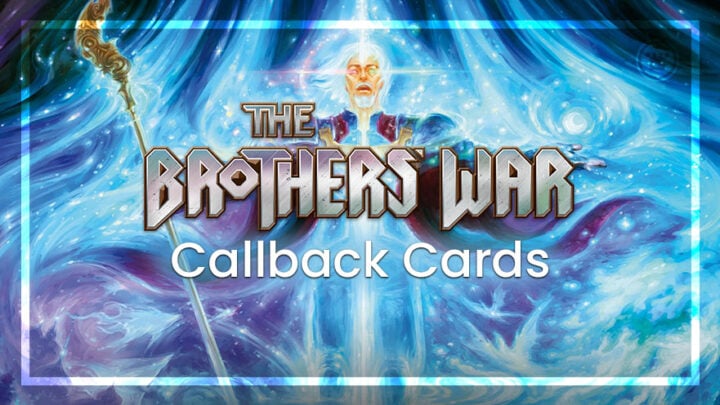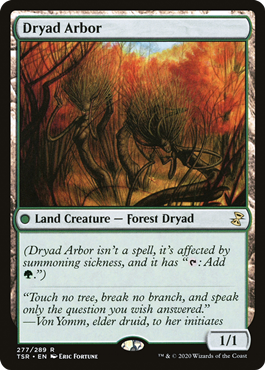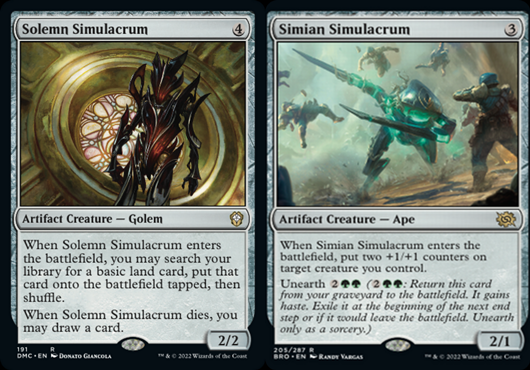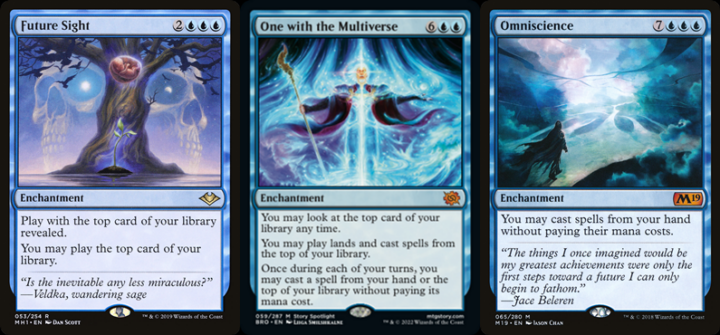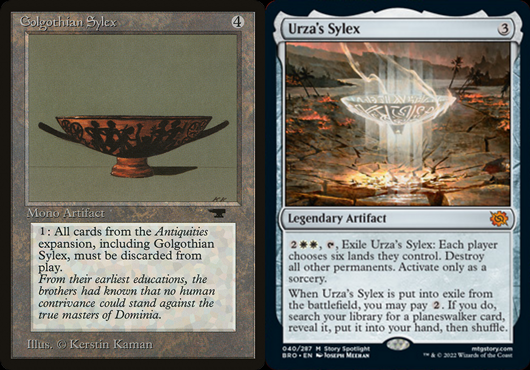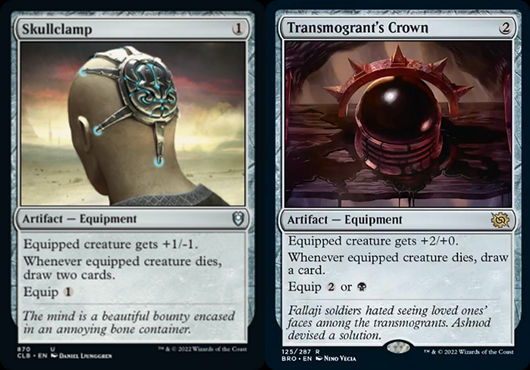The Brothers’ War previews are in full swing, and so far, the cards look like a blast to play. In a set designed to look at Magic’s past, it’s no wonder we’re seeing a lot of callbacks to characters and events from the old lore — often for the first time.
But not everything we’re seeing in BRO takes its inspiration from lore, or at least not entirely. Some of these new cards exist as an update of previous card designs.
Normally this is the sort of thing we see more in supplemental sets like Modern Horizons 2. For example, Diamond Lion updating Lion’s Eye Diamond in a way that’s a little less prone to enabling bonkers combos, or Yavimaya, Cradle of Growth moving Urborg, Tomb of Yawgmoth’s effect over to a new color.
So here are a few examples of these kinds of updates we’re getting in The Brothers’ War, along with my (admittedly highly subjective) thoughts about them.
Dryad Arbor — Awaken the Woods
That’s right — it’s everyone’s favorite rules headache of a land, Dryad Arbor! Awaken the Woods creates tokens that are copies of Dryad Arbor in everything but name, thus acting as a scalable ramp spell and token army generator while avoiding adding another creature that can be fetched from your library with the fetch lands in older formats.
This card is great, in large part due to its drawbacks. Mass ramp spells are usually pretty disheartening to play against, and while this one may also be overwhelming, the fact that all the lands this spell creates are creatures (and therefore unable to tap for mana the turn they enter) gives opponents a reaction window. Also, since this is a sorcery and not a land creature like Arbor, Awaken the Woods avoids a lot of the rules baggage of the older card.
Ramp spells like this also usually live with a bit of tension to them. They’re obviously better the greater you can make X, but by the time you can make X five or more, you’re getting diminishing returns for the use of all those extra lands since ramp is usually most important in the early game. The fact that this ramp card also makes 1/1s in addition to adding lands to your board makes it more generally useful at any stage of the game.
Solemn Simulacrum — Simian Simulacrum
This one is more of a pun than a strict update, as the two cards serve wildly different purposes. Solemn Simulacrum was, for a long time, the poster child of value — a card that could go into any commander deck, fixing and ramping your mana when it entered and drawing a card on its way out. Simian Simulacrum is pure offense, coming in as a three-mana 4/3 if you use its ability on itself or spreading those counters around a couple of times if you have a better target.
All in all, I still like Sad Robot between these two cards. Its day in the sun in Commander may have long since passed, but at more casual tables, it’s still a welcome sight that, again, fits into nearly every deck.
Simian Simulacrum is much more focused, and much less likely to make a dent in Commander. I can see it having a home in Standard, especially if Mono Green or Green/Red Stompy decks are at all viable in the format.
Future Sight/Omniscience (Kinda) — One With the Multiverse
One with the Multiverse is admittedly a bit of a stretch, as this isn’t a direct callback to a single card we’ve seen before, and it’s very heavily lore-based in its conception. This card shows off the power of old-school Pre-Mending planeswalkers, but each of its abilities clearly points to a card. So rather than a direct update, this is taking those cards and stapling them together.
Future Sight covers the first ability, allowing you to look at the top card of your library and play it. The second ability… look, it’s not really Omniscience. It’s much closer to the back side of Jacob Hauken, Inspector.
However, Omniscience is way more iconic, and if I say it’s the second half of Hauken’s Insight, people won’t know what I’m talking about. Besides, if the ability on the card was straight-up Omniscience, this would be one of the most broken in half cards ever printed — even at the high mana cost. As it is, this is still likely a game ender if it ever resolves, as you still get at least one free spell even if your opponent has an answer for the enchantment.
Golgothian Sylex — Urza’s Sylex
Golgothian Sylex exists alongside City in a Bottle as cards designed to hose entire expansions. This is obviously a powerful effect, but one that is almost comically over-or-underpowered and ridiculously convoluted in practice.
Enough cards have been reprinted over time in odd places that it’s hard to be sure of a card’s original printing. That means if this ability had persisted throughout Magic’s history, every time a spell like this was cast, it would involve checking the original printings of a bunch of random cards, just to be sure.
In a smaller format like Standard, this effect could be backbreaking. But in a format like Legacy, these would function as silver-bullet answers at best.
So Urza’s Sylex is the Golgothian Sylex, at least lore-wise. They are literally the same object. But Urza’s Sylex is much more generally useful, and giving it a new name allows for an object of this importance to have a greater place in the game.
This is the kind of board wipe that sits on the board and makes your opponent carefully consider adding to their board state, which is often useful. I expect to see this in Commander, where it can certainly punish the players who spend the first few turns just ramping way ahead of everyone else. This may be a bit too clunky for other constructed formats, although Standard usually has more room for a card like this than the more expansive formats.
Skullclamp — Transmogrant’s Crown
All right, here are the cards that inspired this article. Transmogrant’s Crown is a “fixed” Skullclamp, which was famously changed at the last minute to give the equipped creature +1/-1 rather than +1/+0.
That change earned the card a ban and a reputation as a kill-on-sight card draw engine in Commander. Transmogrant’s Crown takes away that -1 to toughness and adds an extra +1 to power. It’s also just a little harder to equip, unless you have access to black mana.
What does this mean for the card? It’s perfectly fine! It’s never going to be the absolute monster Skullclamp is, and that’s OK. This will have a home in Standard aggro decks, maybe make a splash in Pioneer or Modern and still be a usable piece in Commander — just with an additional sacrifice outlet necessary to make full use of it.
This is, to me, the A+, No. 1 example of how to take an old design that had major issues and update it to be powerful but not broken. I also like the fact that the design itself is iconic enough that everyone immediately saw what was going on even without a direct callback in the card name or art.
I like me a Lion Diamond well enough, but those kinds of updates can feel a little too on the nose. This just feels a little more elegant to me, fitting right into the set’s themes and lore without sticking out or feeling shoehorned in.
End Step
Magic has a rich history of hiding Easter eggs and callbacks in sets, and The Brothers’ War has much, much more than what I’ve listed here. And with a little more of previews still to go, we may still see even more direct updates of older cards in the set.
Even with what we’ve already seen, this set has been a field day for the Vorthos fans out there, steeped in lore and tradition while still innovating. What’s your favorite take two of a card in Magic’s history? Let me know over on Twitter @fridaynightmeh.

Chris is the Marketing Communications Coordinator (and editor of the blog) at Card Kingdom. He would like to apologize to his son for not holding onto more cards from when he first started playing, as that likely would have paid for college. He enjoys pretty much all formats of Magic, but usually ends up playing decks that make other people dislike playing those formats with him.

